
Tạp chí Khoa học Đại học Thủ Dầu Một ISSN (in): 1859-4433; (online): 2615-9635
https://vjol.info.vn/index.php/tdm 3
PHÂN TÍCH HIỆU NĂNG MẠNG VÔ TUYẾN ĐA TRUY CẬP
KHÔNG TRỰC GIAO THU THẬP NĂNG LƯỢNG
VỚI THIẾT BỊ GÂY NHIỄU
Đỗ Đắc Thiểm(1)
(1) Trường Đại học Thủ Dầu Một
Ngày nhận bài 21/01/2025; Chấp nhận đăng 02/02/2025
Liên hệ email: thiemdd@tdmu.edu.vn
Tóm tắt
Mạng vô tuyến đa truy cập không trực giao thu thập năng lượng đáp ứng tốt các
yêu cầu về hiệu suất năng lượng, hiệu suất phổ và độ tin cậy thông tin trong truyền thông
hiện đại. Bài báo này trình bày kết quả nghiên cứu mô hình đa truy cập không trực giao
thu thập năng lượng với thiết bị gây nhiễu (EHNOMAwJ) nhằm cải thiện hiệu năng bảo
mật bằng phương pháp mô phỏng Monter-Carlo xác suất dừng kết nối/bảo mật và xác
suất dừng hoạt động cho cả thiết bị thu ở xa và gần. Các kết quả cho thấy có sự đánh đổi
giữa độ tin cậy và độ bảo mật. Bài báo còn cho thấy khi lựa chọn hệ số phân chia thời
gian/công suất phù hợp thì mô hình này đạt được hiệu năng bảo mật/độ tin cậy tối ưu.
Ngoài ra, các kết quả còn cho thấy tồn tại các giới hạn về tốc độ truyền tin yêu cầu/dung
lượng bảo mật để tránh mất kết nối hoàn toàn và đạt được bảo mật hoàn toàn. Hơn nữa,
ảnh hưởng của tính phi tuyến thu thập năng lượng đến độ tin cậy truyền thông/bảo mật
thông tin là đáng kể/nhỏ.
Từ khóa: mạng vô tuyến đa truy cập không trực giao, thiết bị gây nhiễu,
thu thập năng lượng, xác suất dừng kết nối/bảo mật
Abstract
PERFORMANCE ANALYSIS OF ENERGY HARVESTING NON-
ORTHOGONAL MULTI-ACCESS NETWORKS WITH JAMMER
Energy harvesting non-orthogonal multiple access (NOMA) networks effectively
meet the demands for energy efficiency, spectral efficiency, and information reliability in
modern communications. To enhance security performance, this paper studies an energy
harvesting non-orthogonal multiple access model with eavesdropping devices
(EHNOMAwJ). The paper employs a Monte Carlo simulation method to analyze the
connection/security outage probability and the operational outage probability for both far
and near receivers. The results indicate a trade-off between reliability and security. The
paper further demonstrates that with an appropriate selection of the time/power splitting
factor, this model achieves optimal security/reliability performance. Additionally, the
results reveal that there are limits on the required transmission rate/security capacity to
avoid complete disconnection and achieve full security. Furthermore, the impact of non-
linear energy harvesting on communication reliability/information security is
significant/small.

Tạp chí Khoa học Đại học Thủ Dầu Một Số 1(74)-2025
https://vjol.info.vn/index.php/tdm 4
1. Giới thiệu
Trong các mạng vô tuyến thế hệ mới hiện nay, việc đảm bảo đường truyền cho một
lượng lớn người dùng trước các thiết bị nghe lén gặp nhiều thách thức (Ngo và cộng sự,
2023). Do đó, các giải pháp cải thiện hiệu năng bảo mật và độ tin cậy cũng như hiệu quả về
quang phổ và năng lượng ngày càng trở nên quan trọng hơn. Đa truy cập không trực giao
(NOMA) được đề xuất là một giải pháp để cải thiện hiệu suất phổ là cho các mạng 5G (Li
và cộng sự, 2024; Zang và cộng sự, 2024; Srinath và cộng sự, 2023). Bằng cách phân phối
các mức công suất khác nhau cho những người dùng khác nhau, NOMA có thể giải mã
thông tin người dùng bằng tính năng khử nhiễu liên tiếp, điều này hứa hẹn sẽ cải thiện hiệu
năng độ tin cậy hơn nữa. Ngoài ra, NOMA còn có thể giúp nâng cao hiệu quả sử dụng năng
lượng bằng cách thu năng lượng tần số vô tuyến (RF) trong môi trường xung quanh. Hiện
nay, các mạch thu năng lượng (EH) đã được tích hợp thành công ở người dùng 5G/6G
(Halimi và cộng sự., 2023). Tuy nhiên, EH đã được mô hình hóa tuyến tính cho khả năng
điều khiển trong hầu hết các phân tích hiệu năng (Wang và cộng sự., 2020; Ge và cộng sự.,
2020; Bouabdellah và cộng sự., 2019; Gosh và cộng sự., 2023). Hơn nữa, bảo mật lớp vật
lý (PLS) sử dụng tính chất lan truyền của các kênh vô tuyến đã được chứng minh là một
giải pháp hiệu quả để cải thiện hiệu năng bảo mật (Loukil và cộng sự., 2023; Kasuki và
cộng sự., 2023). Do đó, PLS cho NOMA được hỗ trợ EH đã thu hút được sự quan tâm đáng
kể từ cả trong công nghiệp và giới học thuật nhằm đáp ứng đồng thời các nhu cầu chính về
hiệu năng bảo mật và bảo mật cao cũng như hiệu quả về năng lượng và quang phổ cho các
mạng vô tuyến thế hệ tiếp theo. Một trong những kỹ thuật PLS hiệu quả để đảm bảo việc
truyền thông an toàn là gây nhiễu nhân tạo, làm suy yếu việc nghe lén có chủ đích nhưng
không gây hại cho việc truyền thông của người dùng mong muốn (Zheng và cộng sự., 2016;
Hu và cộng sự., 2017). Khảo sát các công trình trên, tác giả đề xuất nghiên cứu hiệu năng
của mô hình mạng đa truy cập không trực giao thu thập năng lượng với thiết bị gây nhiễu.
Lưu ý rằng, bài báo này nghiên cứu hiệu năng của hệ thống EHNOMAwJ với kỹ thuật thu
thập năng lượng phi tuyến tính (NLEH), đây là nhân tố mà các công trình trên chưa được
tính đến. Phân tích hiệu năng của mô hình cho thấy những ưu điểm của hệ thống đó là hiệu
năng có độ tin cậy và bảo mật cao cũng như hiệu quả về quang phổ và năng lượng. Sau đây
là nội dung chính của công trình nghiên cứu này.
2. Mô hình hệ thống
Mô hình hệ thống EHNOMAwJ được minh họa như hình 1. Mô hình này cho phép
truyền thông đồng thời từ máy phát NOMA (A) đến hai máy thu NOMA (C và D) để có
hiệu suất phổ cao trong khi thiết bị gây nhiễu được chọn (Jj) từ một nhóm thiết bị gây
nhiễu J làm gián đoạn việc lấy cắp thông tin của thiết bị nghe lén (E) để mang lại hiệu
năng bảo mật cao. A và Jj tự cấp nguồn cho hoạt động của mình bằng cách thu thập năng
lượng từ nguồn (B), có thể là đài phát thanh/truyền hình có công suất phát cao và ổn định
để nâng cao hiệu quả sử dụng năng lượng.
EHNOMAwJ như trên có thể biểu diễn đường xuống trong các mạng truyền thông
di động. A và Jj thu thập năng lượng từ B là bộ nguồn sẵn có (ví dụ: đài phát thanh, đài
phát sóng truyền hình) để cấp nguồn hoạt động. Đối với EHNOMAwJ được đề xuất, B
truyền năng lượng cho A và Jj trong khoảng thời gian α của khối truyền T, tức là giai đoạn
1, trong khi A thực hiện liên lạc đường xuống NOMA tới C và D và bộ gây nhiễu được
chọn Jj trong số các thiết bị gây nhiễu J sẽ gây nhiễu việc nghe lén của E trong phần còn
lại của T, tức là giai đoạn 2.

Tạp chí Khoa học Đại học Thủ Dầu Một ISSN (in): 1859-4433; (online): 2615-9635
https://vjol.info.vn/index.php/tdm 5
Máy phát
(A)
Thu thập năng lượng Gây nhiễu và truyền thông
Giai đoạn 1: αT Giai đoạn 2: (1-α)T
Các thiết bị
gây nhiễu
Nguồn năng
lượng (B)
J1
Jj
JKMáy thu
ở gần (C)
Thiết bị
nghe lén (E) Máy thu
ở xa (D)
Tín hiệu hợp lệ
Tín hiệu gây nhiễu
Tín hiệu năng lượng
Hình 1. Mô hình mạng EHNOMAwJ
Các ký hiệu gba, gac, gad và gae là các độ lợi kênh giữa B và A, A và C, A và D, A
và E, tương ứng trong khi gbj , gjn, gjf , gje là độ lợi kênh giữa B và Jj , Jj và C, Jj và D, Jj
và E, tương ứng. Với giả sử các kênh fading Rayleigh phẳng. Do đó, gkl với tr={ba, ac,
ad, ae, bj, jc, jd, je} được phân phối theo hàm mũ với giá trị trung bình là
.
tr tr
g
=
Để tính đến suy hao đường truyền,
kl
được mô hình hóa thành
v
tr
d
−
trong đó ρ là công
suất pha đinh ở khoảng cách tham chiếu 1m, dkl là khoảng cách từ máy phát đến máy thu
tương ứng và υ là số mũ suy hao đường truyền. Lưu ý rằng các ký hiệu sau đây biểu thị
gtr = |htr|2 trong đó hkl là hệ số kênh.
Ở giai đoạn 1, B truyền năng lượng vô tuyến cho A và Jj. Do đó, A và Jj tích lũy
lượng năng lượng là Wu = αTβP gbu trong đó P là công suất của B và β ∈ (0, 1) biểu thị
hiệu suất chuyển đổi năng lượng; u ={a,j}. Vì giai đoạn 2 kéo dài (1-α)T nên công suất
truyền thông ở giai đoạn 2 được chuyển đổi từ Wu là Wu(1-α)T. Theo NLEH (Solanki và
cộng sự., 2020), công suất A và Jj tiêu thụ ở giai đoạn 2 là
,,
1,
,
1
bu bu bu bu
ubu
bu
Pg Pg gg
Pg
Pg
−
==
−
(1)
trong đó
1P
= −
,
1
= −
,
P
=
và χ là ngưỡng bão hòa công suất. Điều đáng
chú ý là NLEH rõ ràng được đặc trưng bởi (1). Cụ thể hơn, NLEH tạo ra công suất của
Δgbu, tỷ lệ tuyến tính với công suất đầu vào khi nó vượt quá χ; mặt khác, công suất đầu ra
của nó bão hòa ở χ. Ngoài ra, NLEH trở thành thu thập năng lượng tuyến tính khi χ lớn
(χ → ∞).

Tạp chí Khoa học Đại học Thủ Dầu Một Số 1(74)-2025
https://vjol.info.vn/index.php/tdm 6
Trong giai đoạn 2, đường xuống NOMA và hoạt động gây nhiễu được thực hiện
đồng thời, tức là A gửi đồng thời các ký hiệu (xc và xd ) với công suất phát
a
P
trong biểu
diễn NOMA của
( )
1
a c a d
P x P x
+−
đến C và D trong khi thiết bị gây nhiễu được
chọn, cụ thể là Jj, gửi tín hiệu gây nhiễu xj để gây nhiễu E với công suất phát Pj trong đó
2
22 1
c d j
x x x = = =
, xc và xd lần lượt là các ký hiệu của tín hiệu mong muốn
của C và D. Theo cơ chế NOMA, C được phân bổ ít năng lượng hơn D và do đó, δ < 0,5.
Do đó:
• Tín hiệu nhận được tại C là:
( )
( )
1
c ac a c a d jc j j c
y h P x P x h P x
= + − + +
(2)
• Tín hiệu nhận được tại D là:
( )
( )
1
d ad a c a d jd j j d
y h P x P x h P x
= + − + +
(3)
• Tín hiệu nhận được tại E là:
( )
( )
1
e ae a c a d je j j e
y h P x P x h P x
= + − + +
(4)
trong đó
( ) ( )
0, , 0,
c c d d
NN
và
( )
0,
ee
N
lần lượt là nhiễu cộng tại C, D
và E.
Chọn thiết bị gây nhiễu Jj sao cho nó gây nhiễu nhiều nhất trong số tất cả các thiết
bị gây nhiễu tới E. Điều này có nghĩa là chỉ số j được biểu thị bằng
1,
max ie i
iK
j g P
=
. Việc
lựa chọn Jj có thể được thực hiện theo nhiều cách. Ví dụ: mỗi thiết bị gây nhiễu Ji có thể
đặt bộ đếm thời gian độc lập với ngưỡng tỷ lệ nghịch với giePi. Khi đó, Jj là đối tượng gây
nhiễu có thời gian hết hạn sớm nhất.
2.1. Phát hiện tại C và D:
Bởi vì Jj gây nhiễu xj để chỉ gây can nhiễu vào E mà không gây tổn hại đến liên lạc
của C và D, nên máy thu mong muốn (C và D) có thể dự đoán chính xác tín hiệu gây
nhiễu này, có thể được hiểu là được truyền qua khoảng trống đến C và D (Hu và cộng sự.,
2017; Zou, 2017). Theo đó, C và D có thể triệt tiêu hoàn toàn tín hiệu gây nhiễu ra khỏi
yr, cuối cùng tạo ra tín hiệu không nhiễu.
( )
( )
1
v ad a c a d v
y h P x P x
= + − +
với
,v c d=
(5)
Theo
v
y
, C và D phát hiện xc và xd theo nguyên tắc phát hiện dựa trên NOMA. Vì
0,5
nên C phát hiện xd trước tiên bằng cách coi xc là nhiễu. Sau đó, C phát hiện xd từ
c
y
với tỷ lệ tín hiệu trên nhiễu cộng với nhiễu (SINR) là
( )
1a ac
d
cac a c
Pg
gP
−
= +
(6)
Bằng cách triệt tiêu nhiễu do xd tạo ra, C tiếp tục khôi phục xc từ
( )
ˆ1
c e ae a d ae a c e
y y h P x h P x
= − − = +
. Do đó, dựa trên
ˆc
y
, C khôi phục xc với tỷ lệ
tín hiệu trên nhiễu (SNR) như sau:

Tạp chí Khoa học Đại học Thủ Dầu Một ISSN (in): 1859-4433; (online): 2615-9635
https://vjol.info.vn/index.php/tdm 7
cac a
cc
gP
=
(7)
Trong khi đó, D phát hiện xd bằng cách coi xc là nhiễu. Theo đó, D phát hiện xd trực
tiếp từ
f
y
với SINR.
( )
1a ad
d
dad a d
Pg
gP
−
= +
(8)
2.2. Phát hiện tại E:
Thiết bị nghe lén không có thông tin về tín hiệu gây nhiễu xj. Từ đó, dựa trên (4), E
thực hiện việc phát hiện xc và xd theo nguyên tắc phát hiện dựa trên NOMA. Vì δ < 0,5, E
phát hiện xd trước tiên bằng cách coi xc là nhiễu. Sau đó, E phát hiện xd từ
( )
( )
1
e ae a c a d je j j e
y h P x P x h P x
= + − + +
với SINR là
( )
1a ae
d
eae a je j e
Pg
g P g P
−
= ++
(9)
Bằng cách triệt tiêu nhiễu gây ra bởi xd, E tiếp tục phát hiện xc từ
( )
ˆ1
e e ae a d ae a c e
y y h P x h P x
= − − = +
. Theo đó, tuân theo
ˆe
y
, E phát hiện xc với
SINR là:
cae a
eje j e
gP
gP
= +
(10)
Ta thấy từ (9)-(10) rằng Jj làm suy yếu E bằng công suất gây nhiễu là gjePj , điều
này làm giảm đáng kể xác suất phát hiện thành công xc và xd tại E và do đó, cải thiện đáng
kể hiệu năng bảo mật.
3. Phân tích hiệu năng EHNOMAwJ
Đầu tiên, phần này mô phỏng COP/SOP của EHNOMAwJ. COP được xác định là
khả năng dung lượng kênh đạt được ở máy thu mong muốn nhỏ hơn tốc độ dữ liệu mục
tiêu R0. Trong khi đó, SOP được xác định là khả năng dung lượng kênh thu được ở thiết
bị nghe lén nhỏ hơn tốc độ bảo mật dự phòng (R0 -Rs) dành riêng cho việc nghe lén trong
đó Rs là tốc độ bảo mật mục tiêu. Do đó, COP/SOP thể hiện độ tin cậy/bảo mật của việc
truyền tải thông tin.
3.1. Độ tin cậy
Hiệu năng độ tin cậy được đặc trưng bởi COP tại C và D. Khi đó, COP có giá trị
càng thấp thì hiệu năng độ tin cậy càng cao.
COP tại F: COP tại D được biểu diễn dưới dạng:
( )
( )
2 0 0
Pr 1 log 1 Pr
dd
d d d
COP R
= − + =
(11)
trong đó
( )
0/1
021
R
−
= −
. Hệ số của (1-α) trước logarit của (8) là do giai đoạn 2 diễn ra
trong khoảng
( )
1T
−
.

![Giáo trình Công nghệ mạng không dây (Nghề Quản trị mạng máy tính, Trình độ Cao đẳng) - Trường Cao đẳng Thủ Thiêm [Mới nhất]](https://cdn.tailieu.vn/images/document/thumbnail/2025/20250916/kimphuong1001/135x160/13561758013095.jpg)

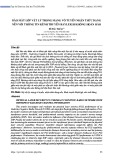

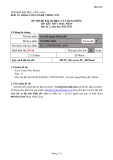
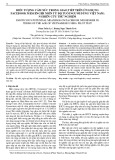
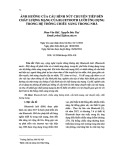
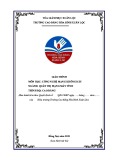
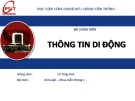
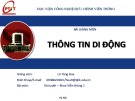






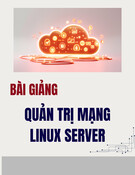
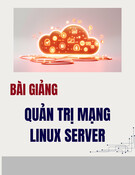

![Đề thi cuối kì Nhập môn Mạng máy tính: Tổng hợp [Năm]](https://cdn.tailieu.vn/images/document/thumbnail/2025/20251110/nminhthoi53@gmail.com/135x160/38281762757217.jpg)


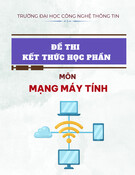
![Đề thi học kì 2 môn Nhập môn Mạng máy tính [kèm đáp án]](https://cdn.tailieu.vn/images/document/thumbnail/2025/20251014/lakim0906/135x160/23811760416180.jpg)

